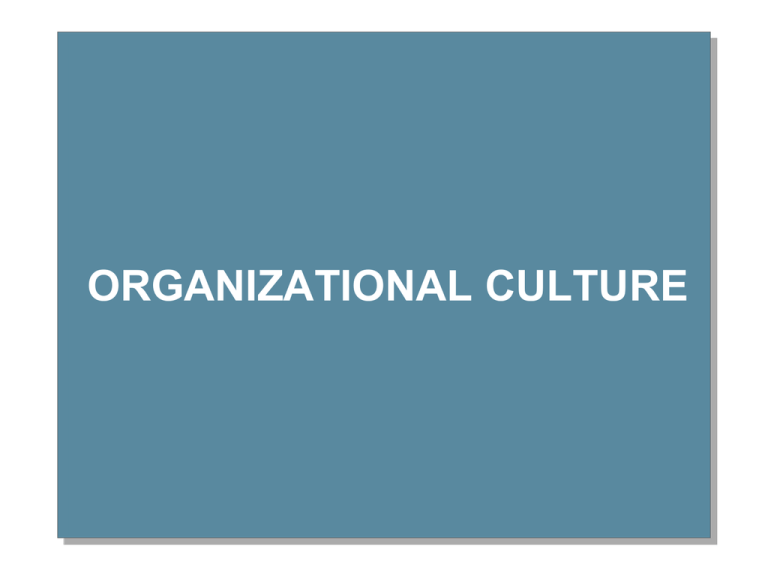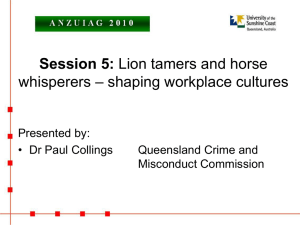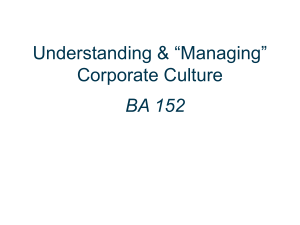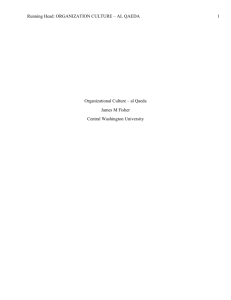Class13
advertisement

ORGANIZATIONAL CULTURE Institutionalization: A Forerunner of Culture Institutionalization When an organization takes on a life of its own, apart from any of its members, becomes valued for itself, and acquires immortality. What Is Organizational Culture? Characteristics: 1. Innovation and risk taking Organizational Culture A common perception held by the organization’s members; a system of shared meaning. 2. Attention to detail 3. Outcome orientation 4. People orientation 5. Team orientation 6. Aggressiveness 7. Stability Contrasting Organizational Cultures Organization A This organization is a manufacturing firm. Managers are expected to fully document all decisions; and “good managers” are those who can provide detailed data to support their recommendations. Creative decisions that incur significant change or risk are not encouraged. Because managers of failed projects are openly criticized and penalized, managers try not to implement ideas that deviate much from the status quo. One lowerlevel manager quoted an often used phrase in the company: “If it ain’t broke, don’t fix it.” There are extensive rules and regulations in this firm that employees are required to follow. Managers supervise employees closely to ensure there are no deviations. Management is concerned with high productivity, regardless of the impact on employee morale or turnover. Work activities are designed around individuals. There are distinct departments and lines of authority, and employees are expected to minimize formal contact with other employees outside their functional area or line of command. Performance evaluations and rewards emphasize individual effort, although seniority tends to be the primary factor in the determination of pay raises and promotions. Contrasting Organizational Cultures Organization B This organization is also a manufacturing firm. Here, however, management encourages and rewards risk taking and change. Decisions based on intuition are valued as much as those that are well rationalized. Management prides itself on its history of experimenting with new technologies and its success in regularly introducing innovation products. Managers or employees who have a good idea are encouraged to “run with it.” And failures are treated as “learning experiences.” The company prides itself on being market-driven and rapidly responsive to the changing needs of its customers. There are few rules and regulations for employees to follow, and supervision is loose because management believes that its employees are hardworking and trustworthy. Management is concerned with high productivity, but believes that this comes through treating its people right. The company is proud of its reputation as being a good place to work. Job activities are designed around work teams, and team members are encouraged to interact with people across functions and authority levels. Employees talk positively about the competition between teams. Individuals and teams have goals, and bonuses are based on achievement of these outcomes. Employees are given considerable autonomy in choosing the means by which the goals are attained. Do Organizations Have Uniform Cultures? Dominant Culture Expresses the core values that are shared by a majority of the organization’s members. Subcultures Mini cultures within an organization, typically defined by department designations and geographical separation. Do Organizations Have Uniform Cultures? Core Values The primary or dominant values that are accepted throughout the organization. Strong Culture A culture in which the core values are intensely held and widely shared. What Is Organizational Culture? Culture Versus Formalization – A strong culture increases behavioral consistency and can act as a substitute for formalization. Organizational Culture Versus National Culture – National culture has a greater impact on employees than does their organization’s culture. – Nationals selected to work for foreign companies may be atypical of the local/native population. What Do Cultures Do? Culture’s Functions: 1. Defines the boundary between one organization and others. 2. Conveys a sense of identity for its members. 3. Facilitates the generation of commitment to something larger than self-interest. 4. Enhances the stability of the social system. 5. Serves as a sense-making and control mechanism for fitting employees in the organization. What Do Cultures Do? Culture as a Liability: 1. Barrier to change. 2. Barrier to diversity 3. Barrier to acquisitions and mergers How Culture Begins Founders Founders hire and keep only employees who think and feel the same way they do. Founders indoctrinate and socialize these employees to their way of thinking and feeling. The founders’ own behavior acts as a role model that encourages employees to identify with them and thereby internalize their beliefs, values, and assumptions. Keeping Culture Alive Selection – Concern with how well the candidates will fit into the organization. – Provides information to candidates about the organization. Top Management – Senior executives help establish behavioral norms that are adopted by the organization. Socialization – The process that helps new employees adapt to the organization’s culture. Stages in the Socialization Process Prearrival Stage The period of learning in the socialization process that occurs before a new employee joins the organization. Encounter Stage The stage in the socialization process in which a new employee sees what the organization is really like and confronts the possibility that expectations and reality may diverge. Metamorphosis Stage The stage in the socialization process in which a new employee changes and adjusts to the work, work group, and organization. A Socialization Model Entry Socialization Options • Formal versus Informal • Individual versus Collective • Fixed versus Variable • Serial versus Random • Investiture versus Divestiture How Organization Cultures Form How Employees Learn Culture • Stories • Rituals • Material Symbols • Language Creating An Ethical Organizational Culture Characteristics of Organizations that Develop High Ethical Standards – High tolerance for risk – Low to moderate in aggressiveness – Focus on means as well as outcomes Managerial Practices Promoting an Ethical Culture – – – – – Being a visible role model. Communicating ethical expectations. Providing ethical training. Rewarding ethical acts and punishing unethical ones. Providing protective mechanisms. Creating a Customer-Responsive Culture Key Variables Shaping Customer-Responsive Cultures 1. The types of employees hired by the organization. 2. Low formalization: the freedom to meet customer service requirements. 3. Empowering employees with decision-making discretion to please the customer. 4. Good listening skills to understand customer messages. 5. Role clarity that allows service employees to act as “boundary spanners.” 6. Employees who engage in organizational citizenship behaviors. Creating a Customer-Responsive Culture Managerial Actions : • Select new employees with personality and attitudes consistent with high service orientation. • Train and socialize current employees to be more customer focused. • Change organizational employees more control. structure to give • Empower employees to make decision about their jobs. Creating a Customer-Responsive Culture Managerial Actions: • Lead by conveying a customer-focused vision and demonstrating commitment to customers. • Conduct performance appraisals based customer-focused employee behaviors. on • Provide ongoing recognition for employees who make special efforts to please customers. Spirituality and Organizational Culture Workplace Spirituality The recognition that people have an inner life that nourishes and is nourished by meaningful work that takes place in the context of the community. Characteristics: • Strong sense of purpose • Focus on individual development • Trust and openness • Employee empowerment • Toleration of employee expression Reasons for the Growing Interest in Spirituality As a counterbalance to the pressures and stress of a turbulent pace of life and the lack of community many people feel and their increased need for involvement and connection. Formalized religion hasn’t worked for many people. The desire to integrate personal life values with one’s professional life. Job demands have made the workplace dominant in many people’s lives, yet they continue to question the meaning of work. An increasing number of people are finding that the pursuit of more material acquisitions leaves them unfulfilled. How Organizational Cultures Have an Impact on Performance and Satisfaction Hofstede Cultural Framework Culture is more often a source of conflict than of synergy. Cultural differences are a nuisance at best and often a disaster." Prof. Geert Hofstede Hofstede Cultural Framework National cultures can be described according to the analysis of Geert Hofstede. These ideas were first based on a large research project into national culture differences across subsidiaries of a multinational corporation (IBM) in 64 countries. Subsequent studies by others covered students in 23 countries, elites in 19 countries, commercial airline pilots in 23 countries, up-market consumers in 15 countries, and civil service managers in 14 countries. Together these studies identified and validated four independent dimensions of national culture differences, with a fifth dimension added later. The drawbacks of applying the Hofstede Model Firstly, the averages of a country do not relate to individuals of that country. One must be aware that not all individuals or even regions with subcultures fit into the mould. It is to be used as a guide to understanding the difference in culture between countries, not as law set in stone. As always, there are exceptions to the rule. Secondly, how accurate is the data? The data has been collected through questionniares, which have their own limitations. Lastly, is the data up to date? How much does the culture of a country change over time, either by internal or external influences? Hofstede Cultural Framework 1. 2. 3. 4. 5. Power Distance Individualism vs. Collectivism Masculinity vs. Femininity Uncertainty Avoidance Long Term Orientation Power Distance “...the extent to which the less powerful members of institutions and organizations within a country expect and accept that power is distributed unequally.” PD P.R.C Russia West Africa Indonesia Hong Kong Netherlands France Japan Germany Canada U.S.A. 100 90 80 70 60 50 40 30 20 10 0 Power Distance at Work Hierarchy Centralization Salary range Participation Ideal Boss Privilege & status symbols Individualism vs. Collectivism Individualist societies: ties are loose and everyone looks out for himself or herself. Collectivist societies: people integrated into strong, cohesive groups; protection is exchanged for loyalty. ID P.R.C Russia West Africa Indonesia Hong Kong Netherlands France Japan Germany Canada U.S.A. 100 90 80 70 60 50 40 30 20 10 0 Individualism / Collectivism at Work Employee-employer relationship Hiring and promotion decisions Managerial focus Task vs. relationship priority Masculinity vs. Femininity Masculine societies: social gender roles are distinct (men focus on material success; women on quality of life). Feminine societies: social gender roles overlap (both quality of life). MA P.R.C Russia West Africa Indonesia Hong Kong Netherlands France Japan Germany Canada U.S.A. 100 90 80 70 60 50 40 30 20 10 0 Masculinity / Femininity at Work Centrality of work Ways of managing & decision making Fem: equality, solidarity, quality of work life Mas: equity, compete, performance Conflict resolution Uncertainty Avoidance “…the extent to which the members of a culture feel threatened by uncertain or unknown situations.” NOT the same as risk avoidance Presence of rules UA P.R.C Russia West Africa Indonesia Hong Kong Netherlands France Japan Germany Canada U.S.A. 100 90 80 70 60 50 40 30 20 10 0 Uncertainty Avoidance at Work Necessity of rules Time orientation Precision & punctuality Interpretation of “What is different…” Appropriateness of emotional displays Long term orientation (Confucian Dynamism) The ‘newest’ dimension three universal dimensions and two fourth dimensions Truth vs. Virtue: What one believes vs. What one does LT P.R.C Russia West Africa Indonesia Hong Kong Netherlands France Japan Germany Canada U.S.A. 120 100 80 60 40 20 0 Confucian Dynamism Short-term orientation Long-term orientation Social pressure to ‘keep up with the Joneses’ small savings expect quick results concern with possessing Truth Thrift: being sparing with resources large savings perseverance toward slow results concern with respecting the demands of Virtue Hofstede Framework Comparisons 140 120 100 U.S.A. 80 Canada Japan Netherlands 60 P.R.C 40 20 0 PD ID MA UA LT Long term orientation at Work Stress on Market Processes Stress on the Individual Stress on Managers rather than Workers The GLOBE framework for assessing cultures In 1993, the Global Leadership and Organizational Behavior Effectiveness (GLOBE) research program is an ongoing cross-cultural investigation of leadership and national culture. Using data from 825 organizations in 62 countries, the GLOBE team identified nine dimensions on which national culture differs. Some of these are: – – – – – – – Power distance Individualism/ collectivism Uncertainty avoidance Gender differentiation Future orientation Humane orientation Performance orientation Edgar H Schein Organizational Culture & Leadership A professor at the MIT Sloan School of Management, is one of the most well known theorists working with organizational culture. "Some are born great, some achieve greatness, and some have greatness thrust upon 'em" Shakespeare, Twelfth Night Edgar H. Schein and Culture He developed a model to explain the basic elements of cultures. Edgar Schein's model resembles the functionalistic models put forward by cultural theorists such as Geert Hofstede and Fons Trompenaars, and can be used to analyze all kinds of cultures including corporate and national cultures. The models put forward by Hofstede, Trompenaars and Schein all presumes that cultures can be explained and understood by looking at the core values and assumptions of a given culture. Core values will shape the visible elements within cultures such as e.g. behaviors, expected behaviors, dress codes etc. Edgar Schein defines these visible elements of cultures as espoused values and artifacts. Defining Organizational Culture Culture is customs and rights. Good managers must work from a more anthropological model. Each organization has its own way and an outsider brings his/her baggage as observer. Understand new environment and culture before change or observation can be made. A pattern of shared basic assumptions that the group learned as it solved its problems of external adaptation and internal integration, that has worked well enough to be considered valid and, therefore, to be taught to new members as the correct way you perceive, think, and feel in relation to those problems. Levels of Culture Artifacts On surface – sees – hears – feels Visible products – – – – Language technology products creations style: clothing, manners of address, myths, stories Easy to observe Difficult to decipher symbols are ambiguous Problems in classification Edgar Schein's model of culture contains the following layers: Artifacts They are the visible elements in a culture. Artifacts can be recognized by people not part of the culture. Artifacts can e.g. be dress codes, furniture, art, work climate, stories, work processes, organizational structures etc. The outsider might easily see these artifacts, but might not be able to fully understand why these artifacts have been established. To understand this, outsiders can look at the espoused values in the culture. Edgar Schein's model of culture contains the following layers: Espoused values They are the values normally espoused by the leading figures of a culture. Espoused values could e.g. be represented by the philosophies, strategies and goals sought realized by e.g. leaders. However, the values sought by leaders should be supported by some general and shared assumptions about e.g. how a company should be run, or how employees should be managed. If espoused values by leaders are not in line with the general assumptions of the culture, this might signal trouble. Edgar Schein's model of culture contains the following layers: Assumptions They reflects the shared values within the specific culture. These values are often ill-defined, and will oftentimes not be especially visible to the members of the culture. Assumptions and espoused values are possibly not correlated, and the espoused values may not at all be rooted in the actual values of the culture. This may cause great problems, where the differences between espoused and actual values may create frustrations, lack of morale and inefficiency. Core assumptions can e.g. be assumptions regarding the human nature, human relationships etc. Why to Study Shein? By using Edgar Schein's model, leaders will be able to understand cultural elements, and be able to analyze the relationship between deep rooted assumptions and common business practices within the company. Likewise, leaders can try to change the basic assumptions of a given culture, and hence maybe improve the effectiveness of the company. The latter can therefore be seen as a cultural change process, where basic assumptions are sought changed to fit the wanted espoused values and artifacts of a company. Why to Study Shein? Cultural change may be needed when the environment of the company changes. Competition or new regulations may require a new organizational culture, in which whole new sets of organizational values may be needed. Accordingly, assumptions may have to be changed, so that the company can survive and develop, and so that the values pursued by business leaders will get accepted by the members of the culture.









